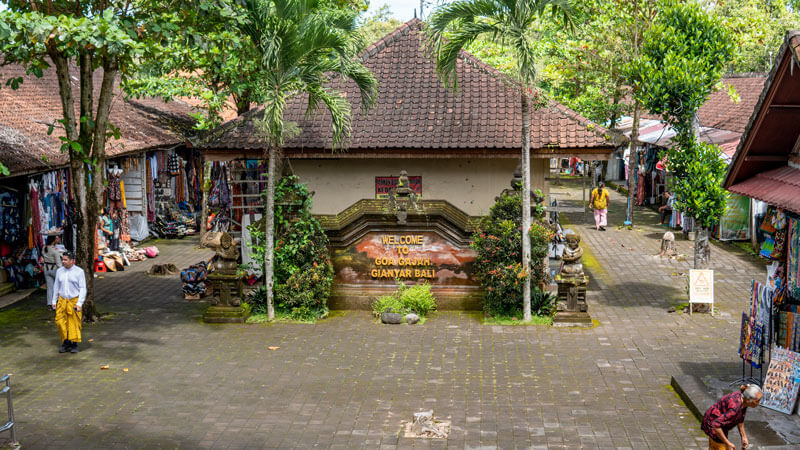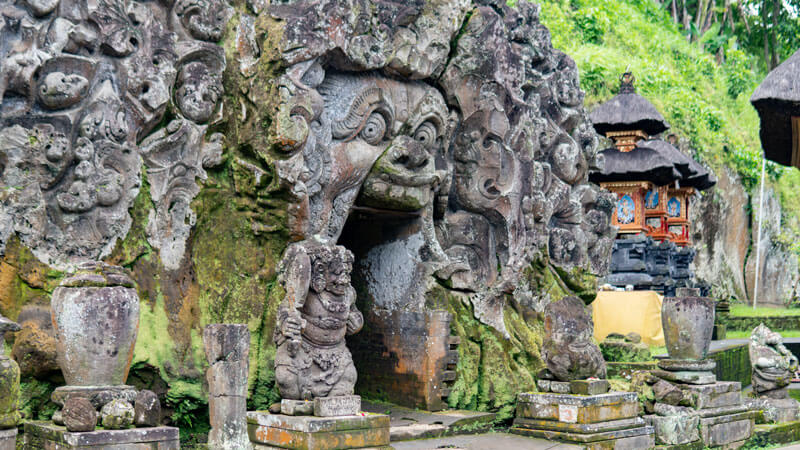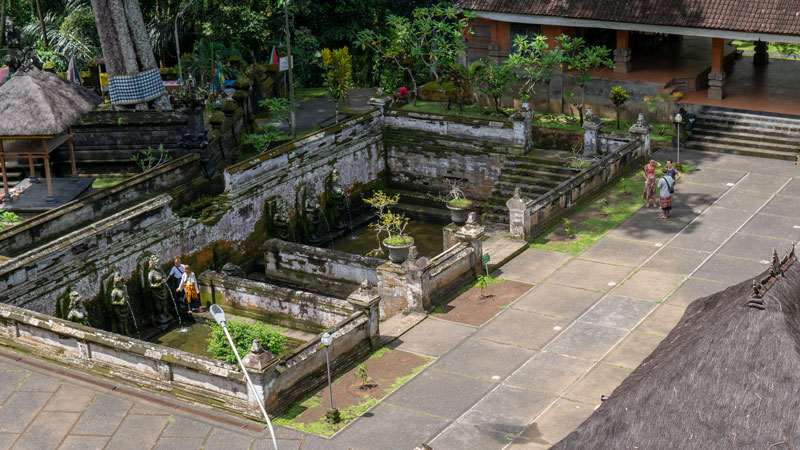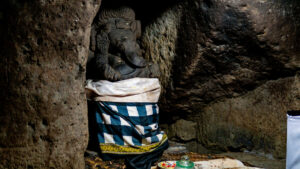Welcome to the definitive guide on the Goa Gajah Temple Entrance Fee. Situated in the heart of Bali’s lush landscape, this archaeological marvel invites travelers from around the globe, including those from India and Arab nations, to delve into its rich historical tapestry. Understanding the entrance fee is crucial in planning a seamless visit to this renowned sanctuary. Our guide is meticulously crafted, providing the latest and most accurate information on entry costs, essential visitation details, and streamlined advice to enhance your journey to this captivating Elephant Cave Temple corner in Bali. While Goa Gajah Temple is often called the Elephant Cave Temple, visitors may be intrigued to discover that, despite its name, there are no actual elephants within its historic cave.

List of Topics[Hide][Show]
Where to Purchase Your Goa Gajah Temple Entrance Tickets
Commence your exploration by acquiring tickets directly at Goa Gajah, Bedulu Village, Blahbatuh District, Gianyar Regency, Bali. To navigate effortlessly to this historical gem, leverage the Goa Gajah location map on Google Maps.
The Most Recent Update on the Goa Gajah Temple Entrance Fee

We are committed to delivering the most recent and precise information about the Goa Gajah Temple Entrance Fee. As of December 29, 2024, the following are the updated fees, which are subject to change:
Detailed Breakdown of the Current Goa Gajah Temple Entrance Fee
Embarking on an adventure to Goa Gajah necessitates an understanding of the latest entrance fee details:
| Category | Price |
|---|---|
| Domestic Adult | IDR 30,000 per person |
| Domestic Child (5-11 years old) | IDR 15,000 per person |
| Foreign Adult | IDR 50,000 per person |
| Foreign Child (5-11 years old) | IDR 25,000 per person |
Moreover, your Goa Gajah Temple Entrance Fee encompasses affordable parking, enhancing the convenience of your visit:
- IDR 5,000 for cars
- IDR 2,000 for motorcycles
Remain updated by exploring the most recent entrance fee list for other tourist destinations in Bali. This link provides a comprehensive overview of entry costs across the island, enabling you to plan efficiently.
Goa Gajah Temple Entrance Fee Payment Options

To facilitate a hassle-free visit, the Goa Gajah Temple offers two easy payment methods for the entrance fee: cash and the QRIS system. Choose the method that best suits your convenience and start exploring with ease.
Elephant Cave Temple Operating Hours
Goa Gajah, a serene retreat, welcomes visitors daily from 08:00 to 18:00. Dedicate ample time to immerse yourself in the site’s extraordinary beauty and distinctive charm.
Goa Gajah Temple: Facilities Overview

When visiting Goa Gajah Temple, your entrance fee includes access to essential facilities that enhance your visit.
- Parking: Ample space for vehicles, making your arrival and departure smoother.
- Public Toilets: Clean and well-maintained amenities for your comfort.
- Refreshment Stalls: Offering local snacks.
- Rest Areas: For moments of relaxation.
Be mindful that specific amenities may have extra costs. Plan accordingly for a comfortable experience.
Maximizing Your Visit: A Guide to Goa Gajah Temple Etiquette and Tips

Adhering to local customs is vital during your visit. Here’s how to ensure a respectful and enriching experience:
Purchase and Secure Your Ticket
Secure your entrance ticket before exploring Goa Gajah. Upon entry, officials will verify your ticket, ensuring you’re all set for your journey through this historic site.
Etiquette and Visiting Procedures:
- Wearing a Shawl: Upon entry, visitors are provided with complimentary shawls as a mark of respect for this sacred site. It is customary to wear these around your waist as you enter, honoring Bali’s spiritual and cultural traditions. For a comprehensive understanding of temple visit etiquette and dress codes, consider reading the dress rules in Bali’s temples.
- Respect for the Site: Goa Gajah, a historical and spiritual significance site, commands respect. Refrain from touching the ancient reliefs and statues, and demonstrate polite and appreciative behavior during your visit.
- Respecting Local Regulations: In alignment with local customs, menstruating women are respectfully asked to abstain from entering the sacred areas. This practice is not exclusive to Goa Gajah but is common across many sacred sites in Bali. To further explore Bali’s spiritual heritage, this guide to the 10 Best Temples in Bali is quite insightful for planning your next visit.
The Guide to Visiting Goa Gajah provides advice and insights about the temple, focusing on ensuring a memorable and respectful visit.
Visiting Goa Gajah Temple Bali: A Comprehensive Guide

Best Times for Visiting Elephant Cave Temple
Early mornings offer quieter exploration for an optimal visit to Goa Gajah Temple, and Bali’s dry season from April to October provides better weather conditions.
Consider off-peak months like May-June or September-October for a more personal experience with fewer crowds.
Remember, the entrance fee is consistent throughout the year, but the time of your visit can significantly influence your experience. For more information, read this comprehensive guide: Explore the Best Times to Visit Bali.
Tracing the Footsteps of Goa Gajah Temple: The Spiritual Heritage of the Island of the Gods

Discover tranquillity and spirituality in the serene surroundings of Goa Gajah in Bali. Known locally as ‘Gua Gajah’, this historical site features ancient reliefs and statues of the deity Ganesha, creating an atmosphere conducive to meditation and reflection.
Nestled amidst verdant nature, Goa Gajah is a testament to Bali’s rich cultural heritage. It is a place where visitors can immerse themselves in contemplation and appreciation of the country’s history.
The name ‘Goa Gajah’ is believed to derive from the intricate elephant reliefs or the revered Ganesha statues found within its confines, which add layers of enigma and history to its allure.
The site harmoniously blends spirituality and religion with Ganesha statues and symbolic holy pools that hold profound significance for many pilgrims.
To delve deeper into the history and significance of Goa Gajah, consider exploring its detailed chronicles on the Goa Gajah Wikipedia page.
Enhancing Your Elephant Cave Temple Visit: The Optional Benefit of a Tour Guide

While the Goa Gajah Temple Entrance Fee provides access to the temple, considering a local tour guide can further enrich your visit. This service is optional, but many find the additional insight and context valuable. Here’s what a guide can offer:
- In-depth Knowledge: They bring the temple’s history and cultural significance to life, explaining each relief and statue in detail.
- Efficient Navigation: Guides know the temple well, helping you focus on the highlights and avoid crowded spots.
- Effective Communication: With multilingual skills, guides ensure language barriers don’t hinder your experience.
If you decide to enhance your visit with a guide, we recommend booking through verified travel agents in Bali or inquiring on-site. Always confirm the guide’s credentials and the total cost before committing.
Remember, this is an optional addition to your visit, and the Goa Gajah Temple offers a rich experience with or without a guide.
Goa Gajah Temple: Essential Visit Information

Before visiting Goa Gajah Temple, check the latest entrance fees, ranging from IDR 15,000 to IDR 50,000. The temple is open every day from 08:00 to 18:00.
Respect the temple by wearing a free shawl and following the local guidelines. After confirming their fees and credentials, consider enhancing your visit with a knowledgeable tour guide.
Plan your visit according to Bali’s seasonal weather and dress appropriately for a comfortable experience. After exploring Goa Gajah, you might visit Gunung Kawi Temple Tampak Siring nearby for further spiritual discovery.
Further Explorations After Elephant Cave Temple
Once you’ve experienced the serenity of Goa Gajah Temple, if your schedule allows, you should consider visiting nearby natural and cultural sites.
- Kuta Beach and Tegalalang Rice Terrace are tranquil spots perfect for relaxation.
- Tanah Lot Temple and Ulun Danu Beratan Temple offer unique perspectives on Bali’s spiritual history.
- The sacred Tirta Empul Temple and the family-friendly Bali Zoo are excellent options if you’re looking for variety.
These destinations are optional but can add depth to your Bali visit.
Bahasa Indonesia:

 5 Hidden Beaches in East Bali: Your Ultimate Guide For Serenity in [2025]
5 Hidden Beaches in East Bali: Your Ultimate Guide For Serenity in [2025]
Leave a Reply